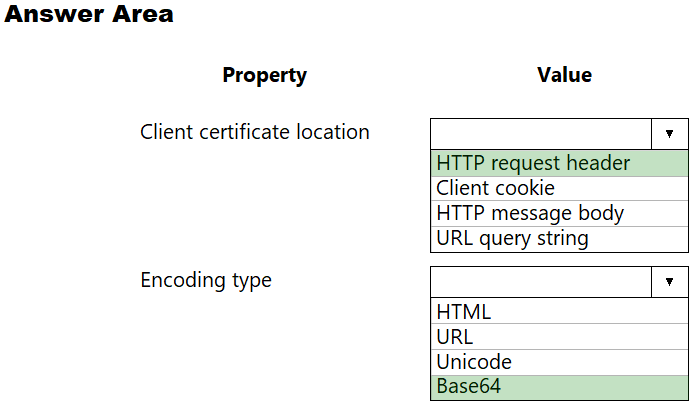Microsoft AZ-303 Exam Practice Questions (P. 2)
- Full Access (334 questions)
- Six months of Premium Access
- Access to one million comments
- Seamless ChatGPT Integration
- Ability to download PDF files
- Anki Flashcard files for revision
- No Captcha & No AdSense
- Advanced Exam Configuration
Question #11
You have an Azure subscription.
You have 100 Azure virtual machines.
You need to quickly identify underutilized virtual machines that can have their service tier changed to a less expensive offering.
Which blade should you use?
You have 100 Azure virtual machines.
You need to quickly identify underutilized virtual machines that can have their service tier changed to a less expensive offering.
Which blade should you use?
- AMetrics
- BCustomer insights
- CMonitor
- DAdvisorMost Voted
Correct Answer:
D
Advisor helps you optimize and reduce your overall Azure spend by identifying idle and underutilized resources. You can get cost recommendations from the Cost tab on the Advisor dashboard.
Reference:
https://docs.microsoft.com/en-us/azure/advisor/advisor-cost-recommendations
D
Advisor helps you optimize and reduce your overall Azure spend by identifying idle and underutilized resources. You can get cost recommendations from the Cost tab on the Advisor dashboard.
Reference:
https://docs.microsoft.com/en-us/azure/advisor/advisor-cost-recommendations
send
light_mode
delete
Question #12
HOTSPOT -
You have an Azure Active Directory (Azure AD) tenant named contoso.com. The tenant contains the users shown in the following table.
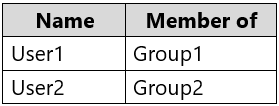
The tenant contains computers that run Windows 10. The computers are configured as shown in the following table.
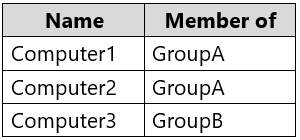
You enable Enterprise State Roaming in contoso.com for Group1 and GroupA.
For each of the following statements, select Yes if the statement is true. Otherwise, select No.
NOTE: Each correct selection is worth one point.
Hot Area:

You have an Azure Active Directory (Azure AD) tenant named contoso.com. The tenant contains the users shown in the following table.

The tenant contains computers that run Windows 10. The computers are configured as shown in the following table.

You enable Enterprise State Roaming in contoso.com for Group1 and GroupA.
For each of the following statements, select Yes if the statement is true. Otherwise, select No.
NOTE: Each correct selection is worth one point.
Hot Area:

Correct Answer:

Enterprise State Roaming provides users with a unified experience across their Windows devices and reduces the time needed for configuring a new device.
Box 1: Yes -
Box 2: No -
Box 3: Yes -
Reference:
https://docs.microsoft.com/en-us/azure//////active-directory/devices/enterprise-state-roaming-overview

Enterprise State Roaming provides users with a unified experience across their Windows devices and reduces the time needed for configuring a new device.
Box 1: Yes -
Box 2: No -
Box 3: Yes -
Reference:
https://docs.microsoft.com/en-us/azure//////active-directory/devices/enterprise-state-roaming-overview
send
light_mode
delete
Question #13
HOTSPOT -
You have an Azure Resource Manager template named Template1 in the library as shown in the following exhibit.
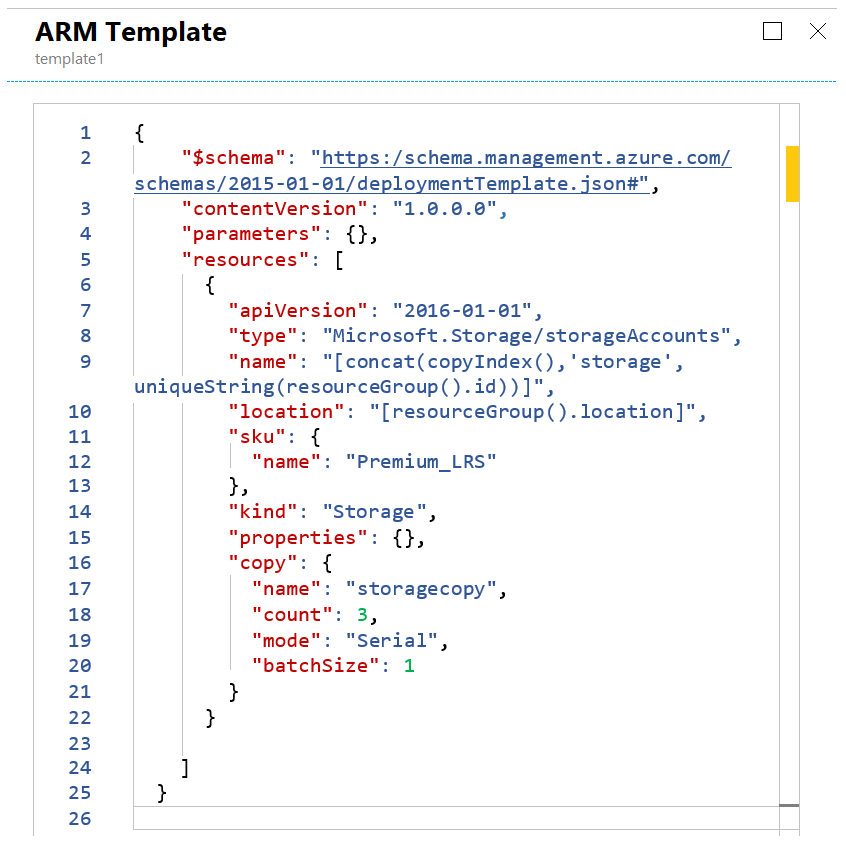
Use the drop-down menus to select the answer choice that completes each statement based on the information presented in the graphic.
NOTE: Each correct selection is worth one point.
Hot Area:
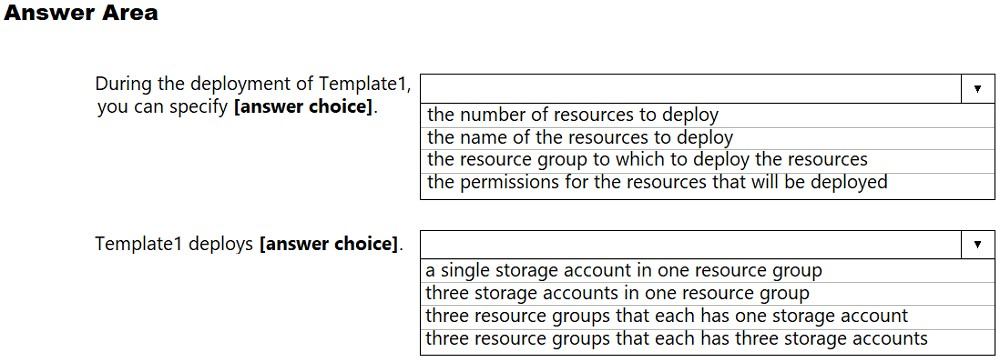
You have an Azure Resource Manager template named Template1 in the library as shown in the following exhibit.

Use the drop-down menus to select the answer choice that completes each statement based on the information presented in the graphic.
NOTE: Each correct selection is worth one point.
Hot Area:

Correct Answer:
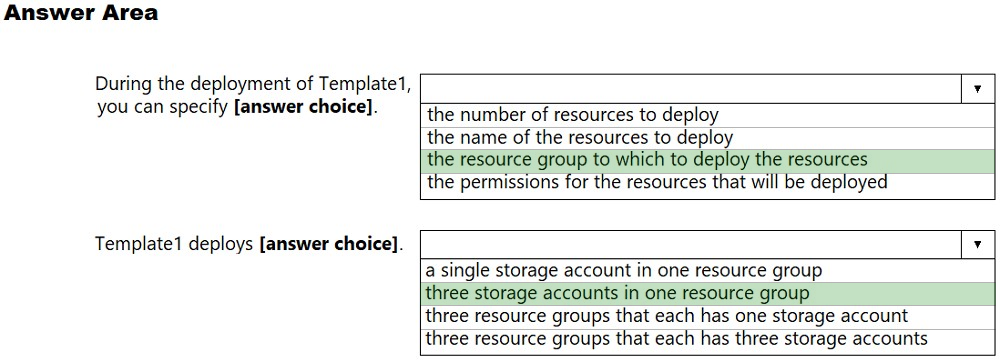
Reference:
https://docs.microsoft.com/en-us/azure/azure-resource-manager/templates/template-syntax

Reference:
https://docs.microsoft.com/en-us/azure/azure-resource-manager/templates/template-syntax
send
light_mode
delete
Question #14
HOTSPOT -
Your company hosts multiple websites by using Azure virtual machine scale sets (VMSS) that run Internet Information Server (IIS).
All network communications must be secured by using end to end Secure Socket Layer (SSL) encryption. User sessions must be routed to the same server by using cookie-based session affinity.
The image shown depicts the network traffic flow for the websites to the VMSS.
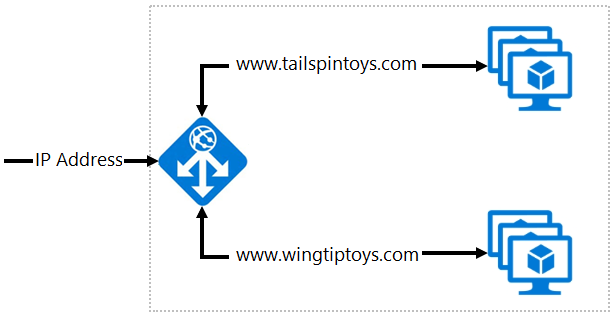
Use the drop-down menus to select the answer choice that answers each question.
NOTE: Each correct selection is worth one point.
Hot Area:
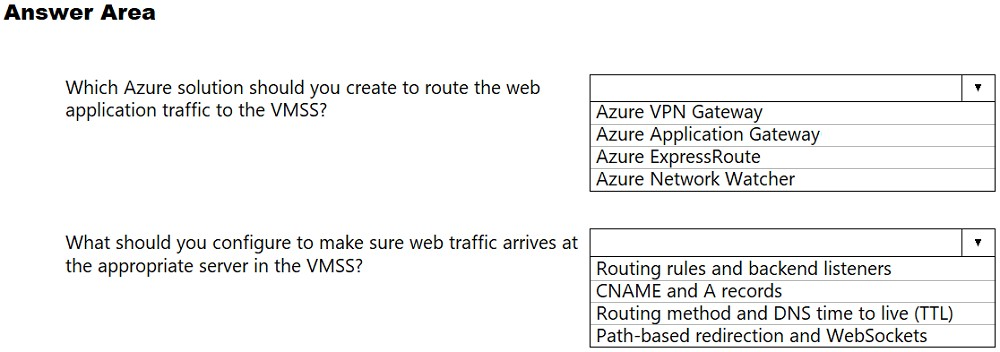
Your company hosts multiple websites by using Azure virtual machine scale sets (VMSS) that run Internet Information Server (IIS).
All network communications must be secured by using end to end Secure Socket Layer (SSL) encryption. User sessions must be routed to the same server by using cookie-based session affinity.
The image shown depicts the network traffic flow for the websites to the VMSS.

Use the drop-down menus to select the answer choice that answers each question.
NOTE: Each correct selection is worth one point.
Hot Area:

Correct Answer:
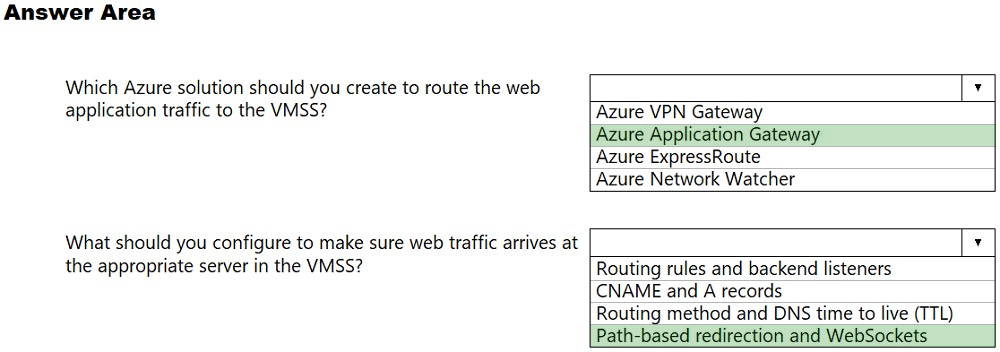
Box 1: Azure Application Gateway
You can create an application gateway with URL path-based redirection using Azure PowerShell.
Box 2: Path-based redirection and Websockets
Reference:
https://docs.microsoft.com/bs-latn-ba/azure//application-gateway/tutorial-url-redirect-powershell

Box 1: Azure Application Gateway
You can create an application gateway with URL path-based redirection using Azure PowerShell.
Box 2: Path-based redirection and Websockets
Reference:
https://docs.microsoft.com/bs-latn-ba/azure//application-gateway/tutorial-url-redirect-powershell
send
light_mode
delete
Question #15
DRAG DROP -
You have an Azure subscription that contains two virtual networks named VNet1 and VNet2. Virtual machines connect to the virtual networks.
The virtual networks have the address spaces and the subnets configured as shown in the following table.

You need to add the address space of 10.33.0.0/16 to VNet1. The solution must ensure that the hosts on VNet1 and VNet2 can communicate.
Which three actions should you perform in sequence? To answer, move the appropriate actions from the list of actions to the answer area and arrange them in the correct order.
Select and Place:
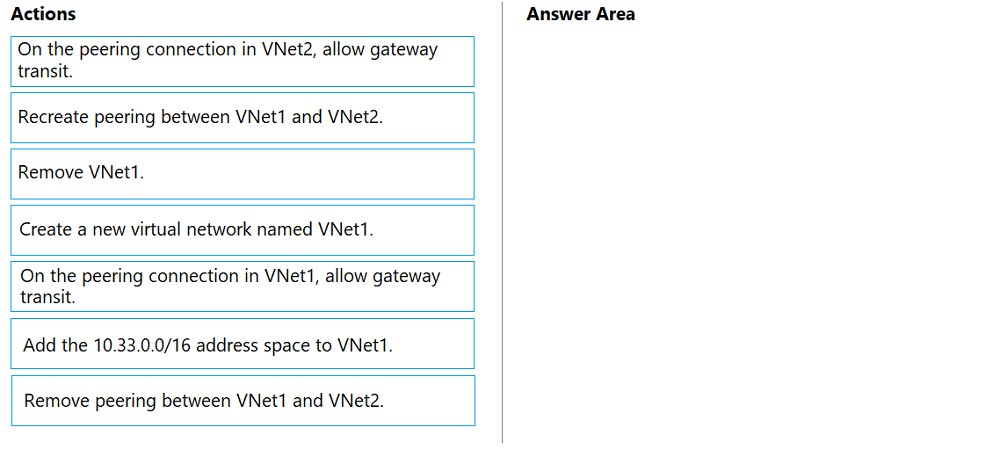
You have an Azure subscription that contains two virtual networks named VNet1 and VNet2. Virtual machines connect to the virtual networks.
The virtual networks have the address spaces and the subnets configured as shown in the following table.

You need to add the address space of 10.33.0.0/16 to VNet1. The solution must ensure that the hosts on VNet1 and VNet2 can communicate.
Which three actions should you perform in sequence? To answer, move the appropriate actions from the list of actions to the answer area and arrange them in the correct order.
Select and Place:

Correct Answer:
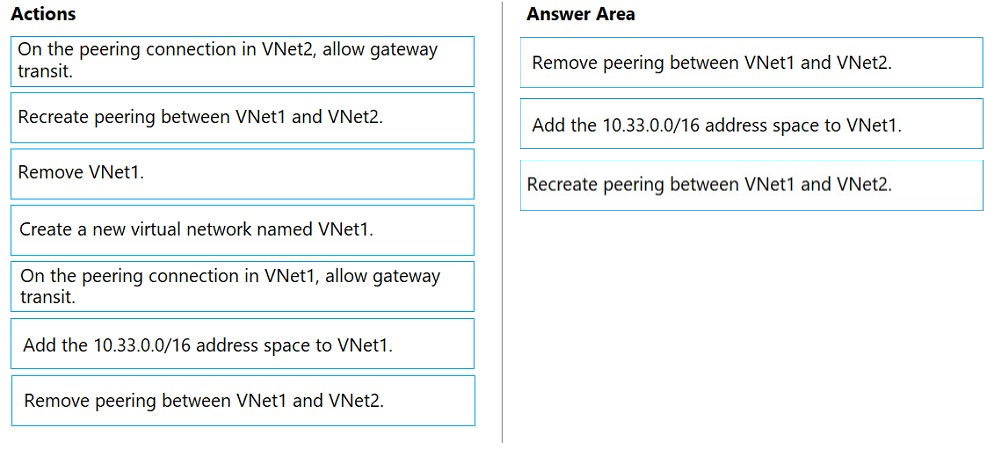
Step 1: Remove peering between Vnet1 and VNet2.
You can't add address ranges to, or delete address ranges from a virtual network's address space once a virtual network is peered with another virtual network.
To add or remove address ranges, delete the peering, add or remove the address ranges, then re-create the peering.
Step 2: Add the 10.44.0.0/16 address space to VNet1.
Step 3: Recreate peering between VNet1 and VNet2
Reference:
https://docs.microsoft.com/en-us/azure/virtual-network/virtual-network-manage-peering

Step 1: Remove peering between Vnet1 and VNet2.
You can't add address ranges to, or delete address ranges from a virtual network's address space once a virtual network is peered with another virtual network.
To add or remove address ranges, delete the peering, add or remove the address ranges, then re-create the peering.
Step 2: Add the 10.44.0.0/16 address space to VNet1.
Step 3: Recreate peering between VNet1 and VNet2
Reference:
https://docs.microsoft.com/en-us/azure/virtual-network/virtual-network-manage-peering
send
light_mode
delete
Question #16
You have an Azure App Service app.
You need to implement tracing for the app. The tracing information must include the following:
✑ Usage trends
✑ AJAX call responses
✑ Page load speed by browser
✑ Server and browser exceptions
What should you do?
You need to implement tracing for the app. The tracing information must include the following:
✑ Usage trends
✑ AJAX call responses
✑ Page load speed by browser
✑ Server and browser exceptions
What should you do?
- AConfigure IIS logging in Azure Log Analytics.
- BConfigure a connection monitor in Azure Network Watcher.
- CConfigure custom logs in Azure Log Analytics.
- DEnable the Azure Application Insights site extension.
Correct Answer:
D
For web pages, Application Insights JavaScript SDK automatically collects AJAX calls as dependencies.
Note: Some of the things you can track or collect are:
What are the most popular webpages in your application, at what time of day and where is that traffic coming from?
Dependency rates or response times and failure rates to find out if there's an external service that's causing performance issues on your app, maybe a user is using a portal to get through to your application and there are response time issues going through there for instance.
Exceptions for both server and browser information, as well as page views and load performance from the end users' side.
Reference:
https://azure.microsoft.com/en-us/blog/ajax-collection-in-application-insights/ https://blog.pragmaticworks.com/what-is-application-insights
D
For web pages, Application Insights JavaScript SDK automatically collects AJAX calls as dependencies.
Note: Some of the things you can track or collect are:
What are the most popular webpages in your application, at what time of day and where is that traffic coming from?
Dependency rates or response times and failure rates to find out if there's an external service that's causing performance issues on your app, maybe a user is using a portal to get through to your application and there are response time issues going through there for instance.
Exceptions for both server and browser information, as well as page views and load performance from the end users' side.
Reference:
https://azure.microsoft.com/en-us/blog/ajax-collection-in-application-insights/ https://blog.pragmaticworks.com/what-is-application-insights
send
light_mode
delete
Question #17
HOTSPOT -
You have an Azure subscription named Subscription1. Subscription1 contains the resources in the following table.
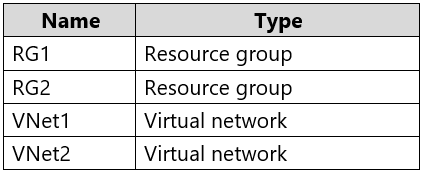
VNet1 is in RG1. VNet2 is in RG2. There is no connectivity between VNet1 and VNet2.
An administrator named Admin1 creates an Azure virtual machine named VM1 in RG1. VM1 uses a disk named Disk1 and connects to VNet1. Admin1 then installs a custom application in VM1.
You need to move the custom application to VNet2. The solution must minimize administrative effort.
Which two actions should you perform? To answer, select the appropriate options in the answer area.
NOTE: Each correct selection is worth one point.
Hot Area:
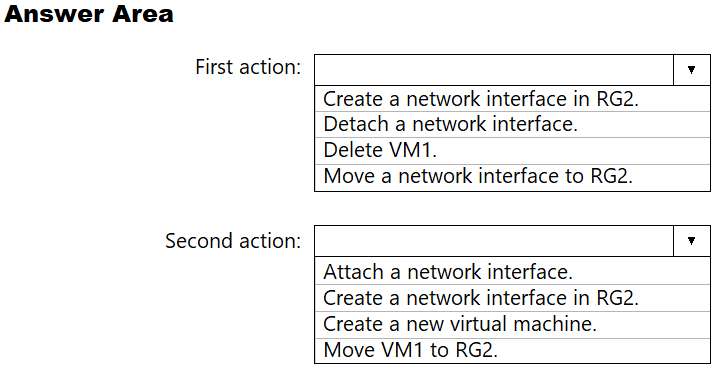
You have an Azure subscription named Subscription1. Subscription1 contains the resources in the following table.

VNet1 is in RG1. VNet2 is in RG2. There is no connectivity between VNet1 and VNet2.
An administrator named Admin1 creates an Azure virtual machine named VM1 in RG1. VM1 uses a disk named Disk1 and connects to VNet1. Admin1 then installs a custom application in VM1.
You need to move the custom application to VNet2. The solution must minimize administrative effort.
Which two actions should you perform? To answer, select the appropriate options in the answer area.
NOTE: Each correct selection is worth one point.
Hot Area:

Correct Answer:
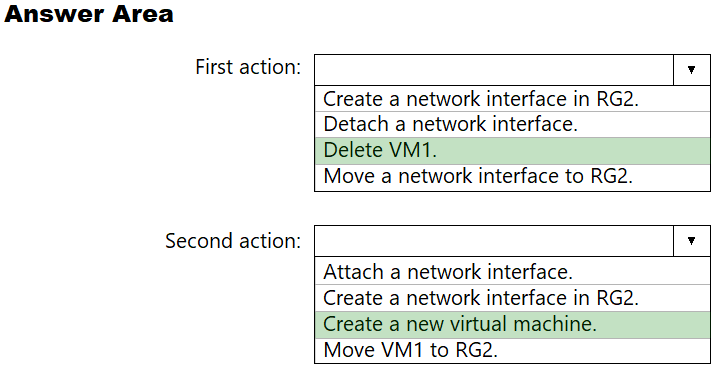
We cannot just move a virtual machine between networks. What we need to do is identify the disk used by the VM, delete the VM itself while retaining the disk, and recreate the VM in the target virtual network and then attach the original disk to it.
Reference:
https://blogs.technet.microsoft.com/canitpro/2014/06/16/step-by-step-move-a-vm-to-a-different-vnet-on-azure/ https://4sysops.com/archives/move-an-azure-vm-to-another-virtual-network-vnet/#migrate-an-azure-vm-between-vnets

We cannot just move a virtual machine between networks. What we need to do is identify the disk used by the VM, delete the VM itself while retaining the disk, and recreate the VM in the target virtual network and then attach the original disk to it.
Reference:
https://blogs.technet.microsoft.com/canitpro/2014/06/16/step-by-step-move-a-vm-to-a-different-vnet-on-azure/ https://4sysops.com/archives/move-an-azure-vm-to-another-virtual-network-vnet/#migrate-an-azure-vm-between-vnets
send
light_mode
delete
Question #18
You have an Azure subscription that contains the storage accounts shown in the following table.
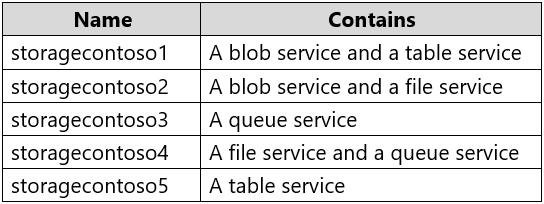
You enable Storage Advanced Threat Protection (ATP) for all the storage accounts.
You need to identify which storage accounts will generate Storage ATP alerts.
Which two storage accounts should you identify? Each correct answer presents part of the solution.
NOTE: Each correct selection is worth one point.

You enable Storage Advanced Threat Protection (ATP) for all the storage accounts.
You need to identify which storage accounts will generate Storage ATP alerts.
Which two storage accounts should you identify? Each correct answer presents part of the solution.
NOTE: Each correct selection is worth one point.
- Astoragecontoso1
- Bstoragecontoso2
- Cstoragecontoso3
- Dstoragecontoso4
- Estoragecontoso5
Correct Answer:
AB
Storage Threat Detection is available for the Blob Service.
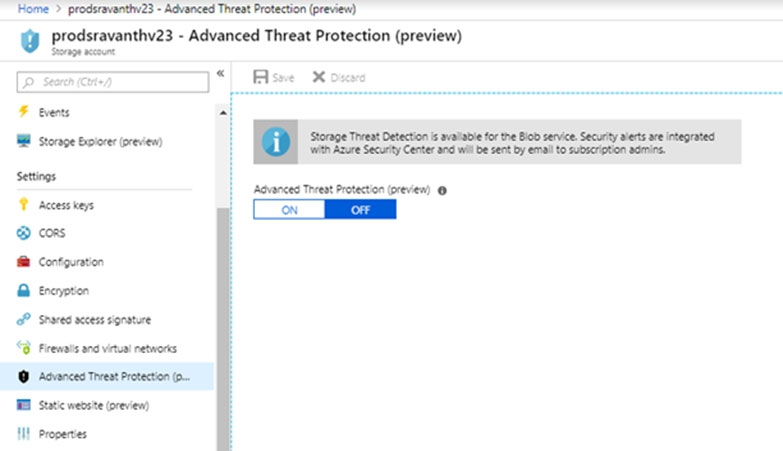
Reference:
https://azure.microsoft.com/en-us/blog/advanced-threat-protection-for-azure-storage-now-in-public-preview/
AB
Storage Threat Detection is available for the Blob Service.

Reference:
https://azure.microsoft.com/en-us/blog/advanced-threat-protection-for-azure-storage-now-in-public-preview/
send
light_mode
delete
Question #19
HOTSPOT -
Your company has an Azure Container Registry named Registry1.
You have an Azure virtual machine named Server1 that runs Windows Server 2019.
From Server1, you create a container image named image1 and then tag image1.
You need to add image1 to Registry1.
Which command should you run on Server1? To answer, select the appropriate options in the answer area.
NOTE: Each correct selection is worth one point.
Hot Area:

Your company has an Azure Container Registry named Registry1.
You have an Azure virtual machine named Server1 that runs Windows Server 2019.
From Server1, you create a container image named image1 and then tag image1.
You need to add image1 to Registry1.
Which command should you run on Server1? To answer, select the appropriate options in the answer area.
NOTE: Each correct selection is worth one point.
Hot Area:

Correct Answer:

An Azure container registry stores and manages private Docker container images, similar to the way Docker Hub stores public Docker images. You can use the
Docker command-line interface (Docker CLI) for login, push, pull, and other operations on your container registry.
Reference:
https://docs.microsoft.com/en-us/azure/container-registry/container-registry-get-started-docker-cli https://docs.docker.com/engine/reference/commandline/push/

An Azure container registry stores and manages private Docker container images, similar to the way Docker Hub stores public Docker images. You can use the
Docker command-line interface (Docker CLI) for login, push, pull, and other operations on your container registry.
Reference:
https://docs.microsoft.com/en-us/azure/container-registry/container-registry-get-started-docker-cli https://docs.docker.com/engine/reference/commandline/push/
send
light_mode
delete
Question #20
HOTSPOT -
You are developing an Azure Web App. You configure TLS mutual authentication for the web app.
You need to validate the client certificate in the web app. To answer, select the appropriate options in the answer area.
NOTE: Each correct selection is worth one point.
Hot Area:
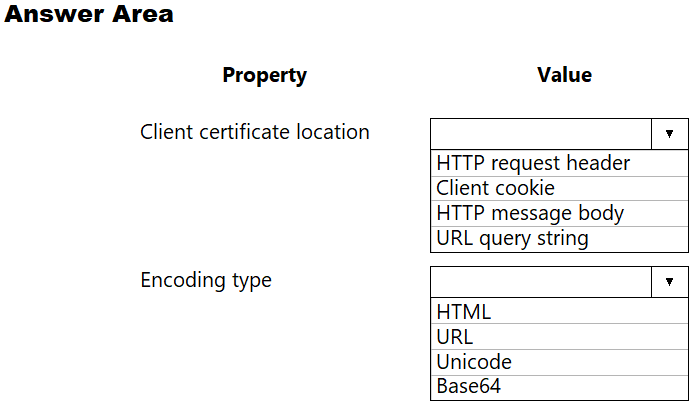
You are developing an Azure Web App. You configure TLS mutual authentication for the web app.
You need to validate the client certificate in the web app. To answer, select the appropriate options in the answer area.
NOTE: Each correct selection is worth one point.
Hot Area:

send
light_mode
delete
All Pages

